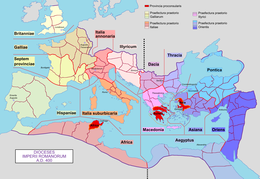 |
|---|
| Periods |
|
| Constitution |
| Political institutions |
| Assemblies |
| Ordinary magistrates |
| Extraordinary magistrates |
| Public law |
| Senatus consultum ultimum |
| Titles and honours |


Vicarius is a Latin word, meaning substitute or deputy. It is the root of the English word "vicar".
YouTube Encyclopedic
-
1/4Views:2 3705 8963 2144 708
-
666 = Image Beast & NOT just Vicarius Filii Dei
-
Vicarius Filii Dei? - Poruka trojice anđela 111
-
Vicarius Filii Dei/Série Curiosidades
-
Fernando Casanova - Vicarius Filii Dei
Transcription
History
Originally, in ancient Rome, this office was equivalent to the later English "vice-" (as in "deputy"), used as part of the title of various officials. Each vicarius was assigned to a specific superior official, after whom his full title was generally completed by a genitive (e.g. vicarius praetoris). At a low level of society, the slave of a slave, possibly hired out to raise money to buy manumission, was a servus vicarius.[1]
Later, in the 290s, Emperor Diocletian carried out a series of administrative reforms, ushering in the period of the Dominate. These reforms also saw the number of Roman provinces increased, and the creation of a new administrative level, the diocese. The dioceses, initially twelve, grouped several provinces, each with its own governor. The dioceses were headed by a vicarius, or, more properly, by a vices agens praefecti praetorio ("deputy of the praetorian prefect"). An exception was the Diocese of the East, which was headed by a comes ("count"). In 370 or 381, Egypt and Cyrenaica were detached from the Diocese of the East and made a diocese under an official called the Augustal Prefect.
In the eastern parts of the Empire, dominated by the Greek language and common use of Greek terminology, a vicarius was called an exarch.[2]
According to the Notitia dignitatum (an early 5th century imperial chancery document), the vicarius had the rank of vir spectabilis; the staff of a vicarius, his officium, was rather similar to a gubernatorial officium. For example, in the diocese of Hispania, the staff of the vicarius included:
- The princeps (i.e. chief of staff) was chosen from among the senior agentes in rebus (couriers or special investigators, 'men of affairs,' from the ministry of the interior headed by the master of the offices), from the salaried class of the ducenarii (those earning 200,000 sesterces a year - the highest regular pay grade in the Roman civil service; the highest officials, governors and above, were not civil service).
- A cornicularius ("chief of staff").
- Two numerarii (chief accountants).
- A commentariensis ("keeper of the commentary", the official diary).
- An adiutor (adjutant; literally "helper", an assistant).
- An ab actis ("acts-keeper", archivist).
- A cura epistolarum ("curator of correspondence").
- An unnamed number of subadiuvae ("deputy assistants").
- Various exceptores (lower clerks).
- Singulares et reliquum officium (various menial staff).
References
- ^ Weaver, P. R. C. (November 1964). "Vicarius and Vicarianus in the Familia Caesaris". The Journal of Roman Studies. 54 (1–2): 117–128. doi:10.2307/298657.
- ^ Meyendorff 1989.
Sources
- Ostrogorsky, George (1956). History of the Byzantine State. Oxford: Basil Blackwell.
- Meyendorff, John (1989). Imperial unity and Christian divisions: The Church 450-680 A.D. The Church in history. Vol. 2. Crestwood, NY: St. Vladimir's Seminary Press. ISBN 9780881410563.
- Notitia Dignitatum[full citation needed]
- Pauly-Wissowa (in German)[full citation needed]
